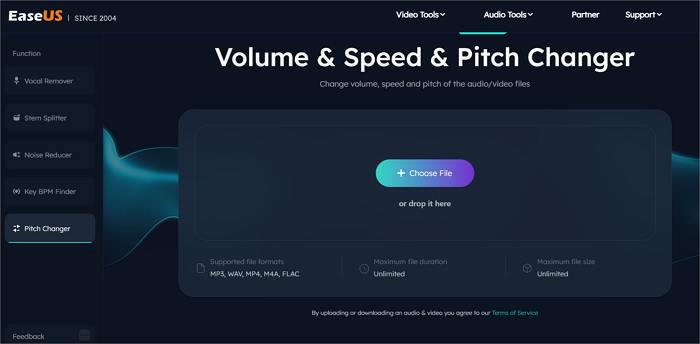-
![]()
Sofia Albert
Sofia has been involved with tech ever since she joined the EaseUS editor team in March 2011 and now she is a senior website editor. She is good at solving various issues, such as video downloading and recording.…Read full bio -
![]()
Alin
Alin is a sophisticated editor for EaseUS in tech blog writing. She is proficient in writing articles related to screen recording, voice changing, and PDF file editing. She also wrote blogs about data recovery, disk partitioning, data backup, etc.…Read full bio -
Jean has been working as a professional website editor for quite a long time. Her articles focus on topics of computer backup, data security tips, data recovery, and disk partitioning. Also, she writes many guides and tutorials on PC hardware & software troubleshooting. She keeps two lovely parrots and likes making vlogs of pets. With experience in video recording and video editing, she starts writing blogs on multimedia topics now.…Read full bio
-
![]()
Gorilla
Gorilla joined EaseUS in 2022. As a smartphone lover, she stays on top of Android unlocking skills and iOS troubleshooting tips. In addition, she also devotes herself to data recovery and transfer issues.…Read full bio -
![]()
Rel
Rel has always maintained a strong curiosity about the computer field and is committed to the research of the most efficient and practical computer problem solutions.…Read full bio -
![]()
Dawn Tang
Dawn Tang is a seasoned professional with a year-long record of crafting informative Backup & Recovery articles. Currently, she's channeling her expertise into the world of video editing software, embodying adaptability and a passion for mastering new digital domains.…Read full bio -
![]()
Sasha
Sasha is a girl who enjoys researching various electronic products and is dedicated to helping readers solve a wide range of technology-related issues. On EaseUS, she excels at providing readers with concise solutions in audio and video editing.…Read full bio
Content
0 Views |
0 min read
FFmpeg is an open-source and free software to process audio, video, and multimedia files. It is a command-line tool widely used for editing audio, video, transcoding, concatenating, video scaling, post-production, effects, and standards compliance. However, one needs to explore various commands to process the multimedia files. In this post, we will see how FFmpeg speed-up video works and how FFmpeg commands speed up and slow down the video.
Speed up/Slow Down Video in FFmpeg
PTS, abbreviated as Presentation Timestamp, is used to speed up or slow down the video with FFmpeg. You need to scale up/down the PTS of each video frame to get the desired results.
The setpts stands for set presentation timestamp and sets the PTS filter command to adjust the frame timestamps, which alters the playback speed. Learn the same with examples for speeding up and slowing down videos with FFmpeg.
Speed up Video in FFmpeg
To speed up a video, we reduce its overall playback. When we process a 20-minute long video with 3/4 (0.75) PTS, the output video will be 15 minutes in length. Similarly, if you do it by 1/2, the final video length will be 10 minutes.
To speed up the video, we multiply the PTS with a value less than 1.0. The command to set the 0.75 PTS to speed up the video will look like this:
ffmpeg -i input.mp4 -vf "setpts=0.75*PTS" output.mp4
The command re-encodes the setpts value to 0.75, speeding the video playback and making the length 15 minutes. The -vf indicates that FFmpeg should apply a video filter. The input and output files are the names of the input and output video files. Here are some examples:
- setpts=0.5*PTS- to speed up the playback by 2 times.
- setpts=0.25*PTS- to speed up the playback by 4 times.
Slow down Video in FFmpeg
Slowing down the video playback is the same as speeding up, except the PTS should be greater than 1.0. The setpts will take any value over 1.0 (positive floating point number) as an argument and do the job.
ffmpeg -i input.mp4 -vf "setpts=2.0*PTS" output.mp4
The "setpts=2.0*PTS" argument slows the video by two times. To slow down YouTube videos without changing pitch, you need to use setpts above 1.0. A 10-minute YouTube video will be 20 minutes long after processing using the FFmpeg. Here are a few other examples:
- setpts=0.25*PTS- Plays the video four times slower than the input.
Bonus: Change Video Playback Speed Online
FFmpeg is a powerful and reliable tool for video and audio processing. All major editing platforms use FFmpeg in the backend to process the audio. However, many do not prefer using FFmpeg because of its complexity. With EaseUS Speed Changer, you don't have to remember complex commands and can change your playback speed with a simple UI.

Upload the video file on the website, use the speed slider to speed up MP3, MP4, and all supported video and audio formats, and download the output video. Along with speed, you can change the pitch of song and volume to furnish the audio. The interface is simple and multiple language support is available. Upload your video on Speed Changer and speed up/slow down the video.
To Conclude
FFmpeg lets users edit the audio and video with command line software. The post discusses FFmpeg speed up video commands to alter the playback speed of videos. Also, learn how to slow down video with FFmpeg. If you find it difficult to remember commands and don't want to download the software for a simple process, EaseUS Speed Changer is always there to help. Upload and change the playback speed to slow down or speed up the video.
FAQs on FFmpeg Speed up Video
Here are some command queries people ask about the FFmpeg speed up video.
1. How can I speed up an existing video?
Many software tools allow you to speed up an existing video online. Upload your video using tools like EaseUS Speed Changer, adjust the speed, and process to speed up the video playback speed.
2. How to increase conversion speed in FFmpeg?
FFmpeg re-encodes all the audio and video streams whenever you try to process them. So, add a -c option to the command to tell FFmpeg to copy the streams without re-encoding to increase the conversion speed.
3. Is FFmpeg faster with GPU?
Yes, GPU acceleration gives FFmpeg great advantages. Encoding and decoding with GPUs becomes faster even for HD content, saving time with an increase in conversion rate.
FFmpeg is a complex command line tool, but once you master it, the video and audio processing becomes way faster. Share the post with your friends and colleagues if you find it helpful.




